1. Gross domestic product grew by 1.9 per cent last year
According to Statistics Finland's revised preliminary data, the volume of Finland’s GDP increased by 1.9 per cent in 2016. The initial preliminary data released in March put the rate of growth at 1.4 per cent. The GDP became revised as new data on intermediate goods used as production inputs in various industries in particular became available. In 2016, Finland's national economy grew after four years of downturn. The national accounts for 2015 were also revised but the changes were minimal.
Figure 1. Annual change in the volume of gross domestic product, per cent
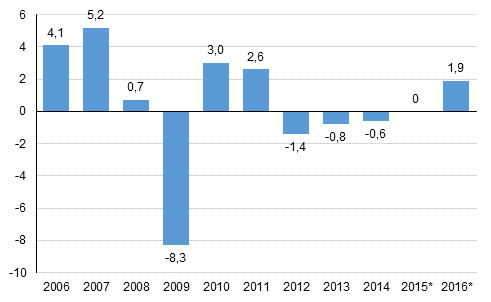
Gross domestic product, or the value added created in the production of goods and services, amounted to EUR 216 billion in 2016 at current prices. GDP per capita was EUR 39,200.
Households' adjusted disposable income describing their economic well-being increased by 0.8 per cent in real terms in 2016. In addition to net income, adjusted income also takes into consideration welfare services produced by the public sector and organisations for households, such as educational, health and social services.
1.1 Production development varied by industry
Viewed by current price, value added increased most in construction, agriculture, forestry and fishing, business activities, other services, information and communication services, and real estate activities, which also includes imputed letting of dwellings. Value added decreased slightly in energy and water supply, public administration and education.
Figure 2. Change in value added at current prices in 2016, per cent.
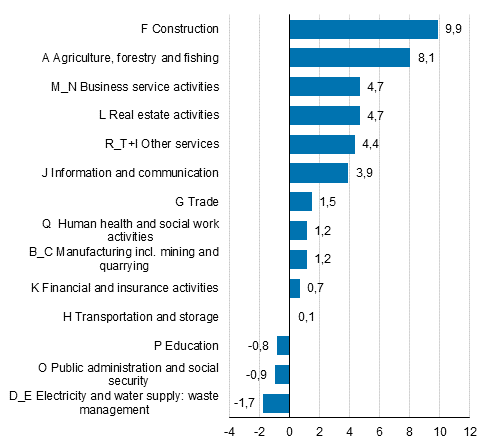
The volume of value added increased most in construction, agriculture, forestry and fishing, and business activities. Volume also grew year-on-year in trade, information and communication services, manufacturing services, real estate activities and other services. The volume of value added declined in energy and water supply and in public administration.
1.2 Households’ consumption and private investments increased demand
Demand in the national economy was mainly boosted by households’ consumption, the volume of which grew by 1.9 per cent. The volume of private consumption grew by 1.8 per cent and the volume of public consumption expenditure by 1.2 per cent. The proportion of consumption expenditure to GDP was 79.2 per cent.
The volume of investments increased by 7.2 per cent. Private investments grew by 7.9 per cent and government investments by 3.9 per cent. Especially construction investments in machinery and equipment increased. By contrast, investments in research and development and in computer software decreased slightly. The investment rate or the proportion of investments of gross domestic product grew to 21.5 per cent.
The volume of exports increased by 1.3 per cent in 2016 and that of imports grew by 4.4 per cent. Import prices declined by clearly more than export prices, imports at current prices increased while exports contracted slightly. Exports of goods decreased but the value of imports of goods increased. Exports and imports of services remained at last year’s level. The share of exports of gross domestic product decreased to 35.2 per cent and the share of imports to 36.5 per cent.
1.3 Work input almost unchanged last year
According to the National Accounts, the number of employed persons grew by 12,500 or 0.5 per cent last year. Jobs increased most in construction and business activities. Jobs decreased most in manufacturing, and in agriculture and forestry. Hours worked increased by 14.8 million hours or 0.4 per cent.
The productivity of labour in the whole national economy, i.e. gross value added at constant prices divided by number of hours worked improved by 1.2 per cent last year.
1.4 Prices rose slightly
The economy’s overall price level rose by 0.9 per cent last year as measured by the GDP price index. By contrast, price changes in individual products may have been large.
Last year, the Consumer Price Index rose by 0.4 per cent, but the price index of household consumption expenditure in National Accounts went up by 0.9 per cent. In National Accounts, the prices of housing services are measured with changes in market rents, whereas the Consumer Price Index also takes into consideration the expenditure on owner-occupied housing. The methods used in National Accounts and in the Consumer Price Index for measuring development in the prices of insurance and financial intermediation services also deviate from each other.
The terms of trade improved by 0.9 per cent because import prices decreased by 2.8 per cent but export prices only by 1.9 per cent.
1.5 National income grew by 3.1 per cent in real terms
Net national income grew by 3.5 per cent in nominal terms last year, and stood at EUR 32,300 per capita. In real terms, net national income grew by 3.1 per cent, which was more than the gross domestic product because the terms of trade improved. Finland's gross national income amounted to EUR 218 billion last year. It was slightly higher than gross domestic product because property income from abroad was higher than property expenditure to abroad.
Households’ wage and salary income increased by 1.5 per cent and employers’ social insurance contributions by 2.5 per cent in 2016. In all, the share of compensation of employees of national income was 58.7 per cent. The respective proportion in the previous year was 59.8 per cent. Property and entrepreneurial income in the national economy increased by 6.5 per cent and its share of the national income rose to 25.2 per cent. The respective proportion in the previous year was 24.5 per cent.
1.6 Non-financial corporations’ profits grew
Non-financial corporations' operating surplus describing profits from their actual operations went up by 3 per cent from the previous year. Non-financial corporations’ entrepreneurial income also increased by three per cent as property income and expenditure changed as much. Entrepreneurial income also takes into consideration property income and paid interests and rents, and corresponds roughly with profit before payment of taxes and dividends.
Non-financial corporations paid eight per cent more direct taxes last year than in the previous year. Non-financial corporations are estimated to have paid five per cent less dividends. The net saving of non-financial corporations increased by EUR 1.5 billion from the previous year.
Figure 3. Non-financial corporations, operating profit from the operations proper (= operating surplus, left column) and net saving (right column), EUR billion
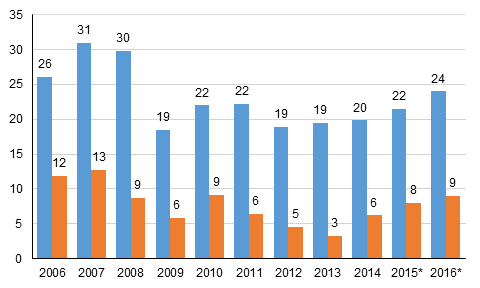
Non-financial corporations’ net lending, or financial position, showed a surplus of EUR 8.7 billion, as against EUR 8.2 billion in the previous year. The financial position improved as profits increased even if non-financial corporations’ investments also grew.
The financial position of financial and insurance corporations showed a deficit of EUR 0.3 billion. Financial corporations’ commission income grew by six per cent and interest income (financial intermediation services indirectly measured) remained at the level of the previous year. The operating surplus of financial corporations contracted by EUR 0.1 billion which was mainly affected by growth in intermediate consumption and contributions collected to the Resolution Fund from credit institutions. Value added of both financial and insurance corporations remained almost unchanged, the operating surplus of financial and insurance corporations also remained at last year’s level.
1.7 General government deficit 1.8 per cent of GDP
General government’s net lending, or financial position, showed a deficit of EUR 3.8 billion, while the deficit was EUR 5.7 billion in the previous year. Last year, the deficit was 1.8 per cent relative to GDP, which was below the three per cent reference value of the European Union.
Last year, the financial position of central government showed a notable deficit for the eight successive year. The deficit (net borrowing) was EUR 5.8 billion, while one year before it was EUR 6.3 billion.
State revenues from taxes went up by 4.5 per cent. Revenues from value added tax grew most but revenues from income taxes and energy taxes also increased.
Current transfers to local government (incl. repayments of value added tax) went up by 4.4 per cent. Current transfers to social security funds grew by 2.5 per cent. Central government's consumption expenditure increased by 3.0 per cent and investments by 4.5 per cent.
The deficit or net borrowing of local government (municipalities and joint municipal authorities, etc.) was EUR 0.9 billion, having been EUR 1.3 billion in the year before. Tax revenues received by municipalities remained unchanged from the previous year. Final consumption expenditure went up by 0.4 per cent in nominal terms mainly due to purchasing of services, and gross fixed capital formation is estimated to have grown by 1.5 per cent.
The surplus of employment pension schemes’ net lending decreased from the previous year. The surplus was now EUR 2.4 billion, while one year before it was EUR 2.7 billion. The surplus was lowered by growth in paid pension benefits. The surplus does not include holding gains in assets. Revenues from pension contributions grew by 0.4 per cent and employment pensions paid by employment pension funds went up by 3.5 per cent mainly as a result of an increase in the number of pensioners. Other social security funds showed a surplus of EUR 0.5 billion having been EUR 0.8 billion in deficit in 2015.
Figure 4. General government surplus/deficit, per cent of GDP
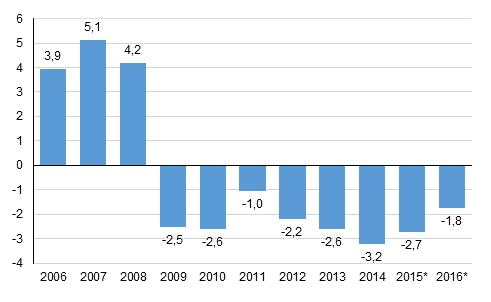
The size of the public economy is described by general government's share of the gross value added, which was 19.7 per cent in 2016, having been 20.4 per cent one year earlier. The proportion of total public expenditure to GDP dropped to 55.8 per cent. In the previous year, the proportion was 56.9 per cent. Total public expenditure includes a notable amount of internal public sector expenses that are included in the calculations twice.
The tax ratio, or the ratio of taxes and statutory social security contributions to GDP, was 44.1 per cent last year. The tax ratio increased by 0.2 percentage points from the previous year.
1.8 Households’ real income grew by one per cent
In 2016, households’ disposable income increased by 1.8 per cent in nominal terms and by 1.2 per cent in real terms. Households’ adjusted disposable income increased by 1.4 per cent in nominal terms and by 0.8 per cent in real terms. Adjusted income also takes into consideration welfare services, i.e. the individual services that general government and organisations produce for households, such as educational, health and social services.
Figure 5. Annual change in households’ disposable real income (left column) and household's adjusted real income (right column), per cent.
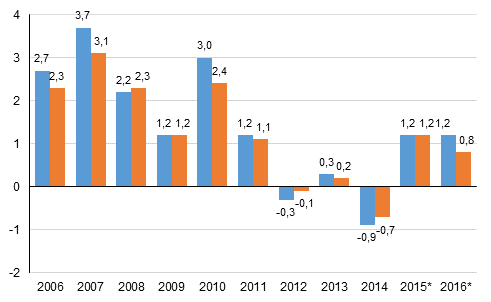
Households’ wage and salary income went up by 1.5 per cent and social benefits by 1.8 per cent. The wages and salaries sum increased as employment grew. Social benefits increased because the number of pensioners grew. Households’ property and entrepreneurial income went up by 6.4 per cent. Direct taxes paid by households and compulsory social security contributions increased by 2.5 per cent.
In 2016, households’ consumption expenditure increased by 2.8 per cent in nominal terms and by 1.9 per cent in real terms. Share of housing of the consumption expenditure grew slightly to 28.4 per cent. Households’ savings rate, i.e. the ratio of savings to disposable income, was negative in 2016, at -0.9 per cent.
Households’ fixed investments primarily in dwellings increased by 14.9 per cent in nominal terms. The financial position of households showed a deficit of EUR 6.3 billion, while the deficit in the previous year was EUR 3.7 billion.
Households' indebtedness ratio grew further and stood at 126.4 per cent at the end of 2016, which was 2.2 percentage points higher than one year earlier. The indebtedness ratio expresses the ratio between the loans and annual disposable net income in accordance with financial accounts.
1.9 Current account deficit EUR 3.0 billion
Finland's current account showed a deficit of EUR 3.0 billion last year. When imports are also valued at FOB price (at the border of the exporting country) and not at CIF price (at the border of the importing country), as is done in the foreign trade statistics of Finnish Customs, the goods trade showed a surplus of EUR 0.2 billion. However, the balance of services trade showed a deficit of EUR 2.9 billion.
EUR 1.6 billion more property income was received from the rest of the world than was paid there. The current transfer outflow was clearly higher than the received income transfers. Data on property income and expenditure are still extremely preliminary.
1.10 Next revision in January 2018
National Accounts for 2015 and 2016 will next be revised in January 2018. These revised preliminary data are based on the information on economic development that was available by 7 July 2017. Methodological descriptions of National Accounts can be found on Statistics Finland’s website at: http://tilastokeskus.fi/til/vtp/men_en.html
Source: National Accounts.
Inquiries: Tuomas Rothovius 029 551 3360, Olli Savela 029 551 3316 , kansantalous@stat.fi
Director in charge: Ville Vertanen
Updated 13.7.2017
Official Statistics of Finland (OSF):
Annual national accounts [e-publication].
ISSN=1798-0623. 2016,
1. Gross domestic product grew by 1.9 per cent last year
. Helsinki: Statistics Finland [referred: 19.12.2025].
Access method: http://stat.fi/til/vtp/2016/vtp_2016_2017-07-13_kat_001_en.html

